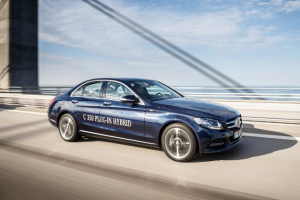Road Test: Mercedes-Benz C 350 e Sport
It might not have seemed it in 1982, but when Mercedes-Benz took the covers off its electric prototype car at the Hanover Trade Fair, it was unveiling what was to become an important technology. A foreshadow for plug-in hybrids which would take another 30 years to find their place in the market.

Mercedes-Benz C350 e
Granted, it was a crude machine compared to today’s equivalents, but the adapted W123-series estate had everything we’d recognise as an early range-extended electric drivetrain. Its 41bhp electric motor would drain the boot full of nickel-iron batteries in 62 miles, after which a two-cylinder petrol engine would kick in to extend the range by another 30.
But the 1979 Oil Shock which led to its inception had passed by that point, and the concept arrived in time for Eighties excess to take over. The conditions – and the technology – it needed weren’t ready in 1982, but they are now. Plug-in hybrids mean low CO2 emissions, which in turn means low company car tax and potentially tiny running costs. So has it finally found its niche, or is it still too good to be true?
It’s certainly no longer a no-frills option. The C 350 e uses a turbocharged four-cylinder petrol engine, sharing a seven-speed automatic transmission with a 60kW electric motor. Heavy-footed driving can combine the two to produce 279bhp, propelling the saloon to 62mph in 5.9 seconds.
Unlike the diesel-hybrid, the lithium-ion battery pack is also mains-rechargeable. So the responsible side of this potent compact executive is an ability to undertake short journeys with the fossil fuel-consuming part of the drivetrain switched off and decouple. That means CO2 emissions of 48gkm, 49g/km for the estate, with combined fuel economy of 134.5mpg – drivers with short commutes could see even more.
This needn’t require much effort. The car can intelligently allocate petrol and electric consumption based on the topography of the route ahead, finding opportunities to use the motor to assist the engine, or to regenerate on downhill stretches. Green-minded driving is also helped by simulated resistance on the throttle pedal, which lets you know that the engine is about to fire up.
Or you can tell it how to behave. Selectable driving modes mean you can save battery power for urban parts of the route, or ramp up the fuel consumption by using the petrol engine as a generator. For short trips, though, it’s best to let the car make the choices. Whether it’s wafting along silently – including decoupling the engine at low loads on the motorway – or effortless bursts of straight-line speed, it’s a pleasure to drive.
But it does require a change of behaviour. Drive it gently and the battery will take you around 16 miles, after which it becomes a not particularly efficient petrol hybrid with fuel economy of around 30mpg. The battery, which takes up around a third of the boot, also requires almost two hours to regain its tiny electric range. With the fallback of a petrol engine, it takes a disciplined driver to battle the elements for such a short amount of silent driving.
Which raises the question of whether it’s perhaps over-incentivised over the excellent diesel-electric C 300 h hybrid. While it lacks the tax breaks and fuel economy claims, and refinement is hamstrung by its ageing 2.1-litre diesel engine, 65mpg motorway economy with no charging stops adds up to a far more versatile economy car. Mercedes-Benz might have cracked electromobility in the years since 1982, but the plug-in C-Class isn’t the model which shows it best.
Verdict:
The C 350 e is technologically brilliant, and a tax-efficient way to get a high-performance C-Class, but a short electric range, long charging times and an inefficient petrol engine mean it’s suited to very specific uses. Most drivers will get better results from the C 300 h.
Specification:
Sector: Compact Executive
Type: Petrol-electric plug-in hybrid
Price: £36,400 (including £2,500 Plug-in Car Grant)
Fuel: 134.5mpg
Electric range: 19 miles
CO2 (tailpipe): 48g/km
Charging port: Type 2 AC


Leave a comment